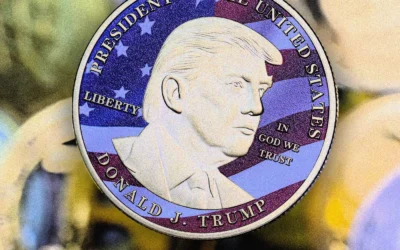Gold Market Volatility: The Impact of Political Rhetoric on Precious Metals
The gold market has always been known for its sensitivity to a myriad of factors, ranging from geopolitical tensions to monetary policy. However, in 2023, the turbulence in the gold market has been particularly pronounced, driven largely by political developments in the U.S. and the statements made by former President Donald Trump. A significant surge in gold prices, followed by a rapid decline, has drawn the attention of investors and analysts alike. This article examines how Trump’s stance towards the U.S. Federal Reserve and ongoing relations with China have directly influenced gold prices, leading to substantial fluctuations in the market.
Gold Surges to New Record High
In the early months of 2023, gold prices experienced a stunning increase, ultimately reaching record highs. Analysts pointed to a combination of factors contributing to this spike, including persistent inflation and a weakening U.S. dollar, but Trump’s repeated attacks on Fed Chairman Jerome Powell seemed to be the most influential. By calling for lower interest rates and criticizing Powell’s policies, Trump fueled fears about the Federal Reserve’s actions and overall economic stability.
As investors seek safe-haven assets in times of uncertainty, gold became the go-to investment for many. Within weeks, the XAU/USD (gold against the U.S. dollar) surged past previous records, driven by speculation and market reactions to Trump’s provocative tone toward the Federal Reserve. Investors were wary of rising inflation and potential market instability and turned to gold as a hedge against such risks.
Market Reaction to Political Rhetoric
The sentiment in the gold market shifted rapidly in response to the political climate in the U.S. Trump’s insistence on the need for more accommodative monetary policies led to heightened volatility. The bond market reacted sharply to these comments, pushing yields lower and sending gold prices soaring. When Trump’s statements intensified, suggesting that Powell should be doing more to support the economy, fear and uncertainty fueled a buying frenzy for gold.
Investors considered Trump’s attacks an indicator of potential political influence over the Fed’s decisions, leading them to worry about maintaining the central bank’s independence. The influx of capital into the gold market, driven by these concerns, pushed the metal’s prices to dizzying heights, making it a focal point in financial media.
Trump Softens Stance, Gold Crashes
However, the euphoric gold rally came to an abrupt halt when Trump softened his stance on both Powell and relations with China. In response to growing fears of a trade war and rising geopolitical tensions, Trump made conciliatory remarks about working with the Fed and engaging in more productive communication with China. As the rhetoric shifted, so did the market sentiment.
The rationale behind Trump’s softer posture stemmed from internal and external pressures. There were signs that the economic recovery was gaining traction, leading many, including Trump, to reassess the necessity of aggressive policy changes. When Trump’s temperate remarks were made public, gold prices took a drastic downturn. The subsequent $200 wipeout in XAU/USD was a clear reflection of the market’s volatility; traders who positioned themselves in anticipation of ongoing conflict found themselves on the wrong side once Trump took a more diplomatic approach.
Implications for Investors and Market Analysts
This erratic behavior in gold prices created a challenging environment for investors and market analysts. Many who had invested heavily in gold during its peak had to hastily reassess their strategies upon witnessing the rapid decline. Risk management took center stage as traders began to re-evaluate positions, aware that political statements could have more influence on their investments than traditional economic indicators.
Direct involvement from political figures like Trump highlights a growing trend where non-economic factors can sway financial markets. This new reality has prompted investors to adapt strategies that take into account the unpredictable nature of political discourse. Analysts and financial advisors thus find themselves needing to understand not only market fundamentals but the broader political landscape to make informed investment decisions.
The Future of Gold in an Evolving Market
As the dust settles from these recent fluctuations, the question remains: what lies ahead for gold in an environment marked by political unpredictability? While immediate reactions are often spurred by fluctuations in rhetoric, the fundamental factors driving gold prices—such as inflation, central bank policies, and global economic conditions—remain critically important.
Gold’s role as a hedge against inflation and economic instability continues to underline its place in investor portfolios. A return to traditional economic triggers may provide a more stable outlook for gold prices in the longer term. However, the events of 2023 have signaled that political narratives can no longer be ignored. Investors must remain vigilant and adapt to the evolving dynamics of global summits and political engagement.
Conclusion: The Interplay of Gold and Politics
The interplay between political discourse and financial markets has always existed, but the recent volatility in gold prices following Trump’s remarks emphasizes the significant impact that such rhetoric can have. It highlights the intersection of global economic health, political leadership, and investor sentiment. As gold remains a vital barometer for market stability, investors must navigate these turbulent waters with a keen awareness of both economic indicators and political developments.
The gold market will undoubtedly continue to react to political statements and shifts in sentiment. Therefore, stakeholders at all levels—whether they are individual investors, financial advisors, or institutional stakeholders—should cultivate a deep understanding of the political landscape that shapes the market. Gold’s path forward will likely be a reiteration of the age-old adage: “history never repeats itself but it often rhymes.” Hence, constant vigilance is essential as we move ahead into an uncertain economic future.







